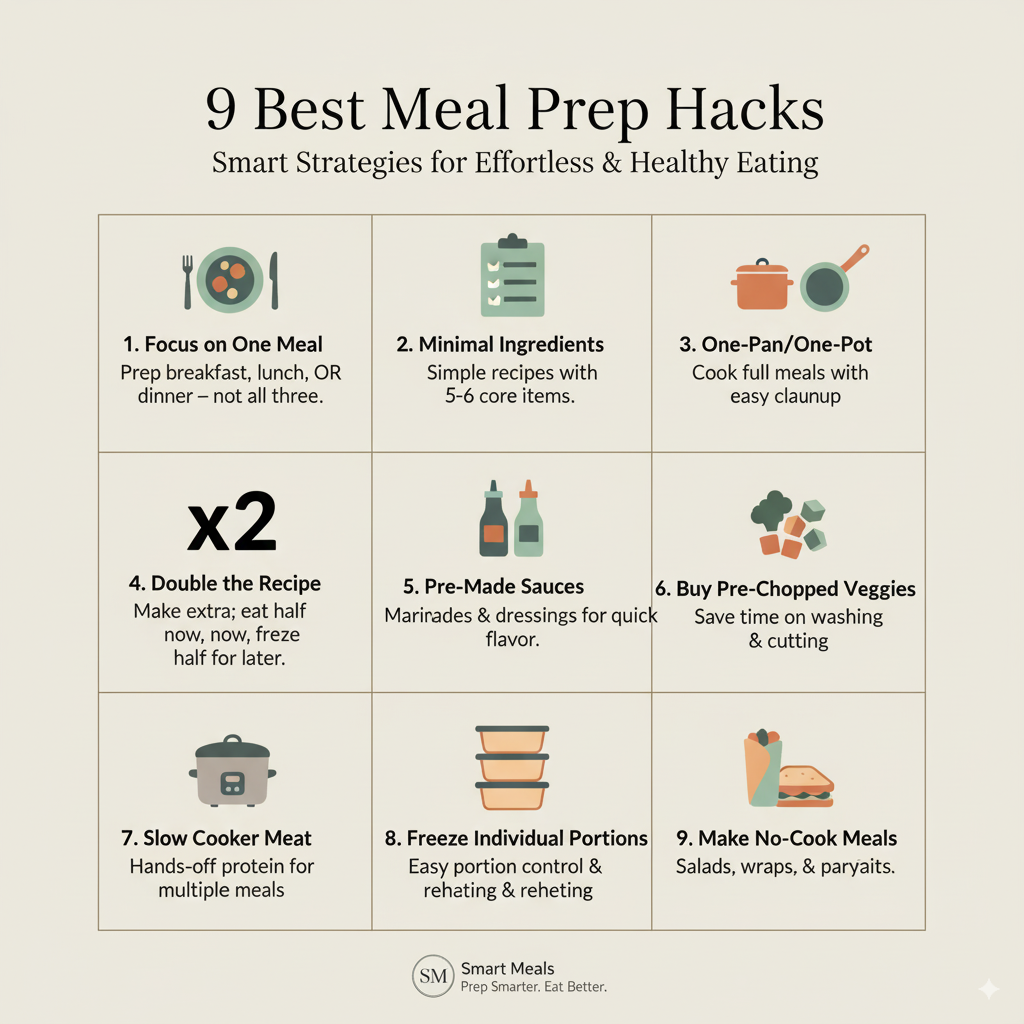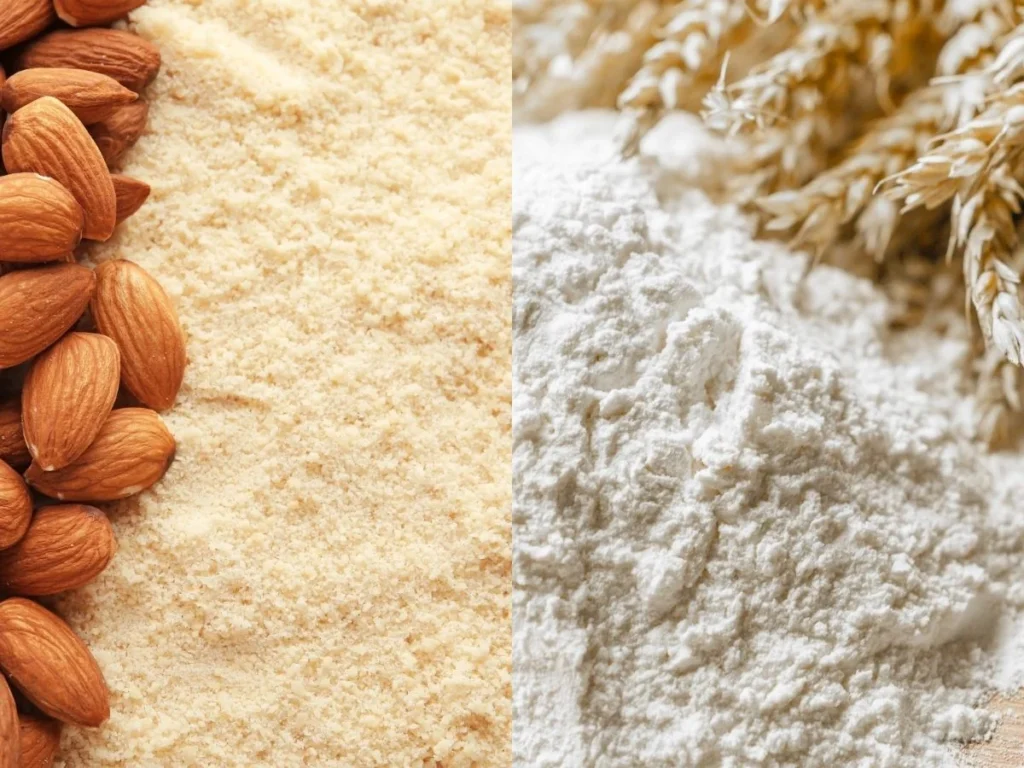Meal prep has become one of the most effective strategies for eating healthier, saving money, and reducing the stress of cooking every single day. But for many people, the idea of spending the whole weekend chopping vegetables and lining up identical food containers can feel overwhelming and even discouraging. The good news is that meal prep doesn’t need to be boring or complicated. With a few smart strategies, you can save hours in the kitchen while still enjoying meals that are flavorful, balanced, and satisfying. Whether you’re trying to lose weight, fuel workouts, or simply eat better at work and home, these 9 meal prep hacks will help you stay consistent without feeling like a full-time chef.
Table of Contents

1. Focus on One Meal
A common mistake is thinking you need to prep breakfast, lunch, and dinner for the entire week. That’s too much work and usually ends up overwhelming beginners. Instead, start with the meal that gives you the most trouble. If you’re always rushing in the morning, prepare grab-and-go breakfasts like overnight oats, chia pudding, or egg muffins. If you spend too much money buying lunch, pack your own healthy grain bowls or sandwiches. If evenings are hectic, prep dinner staples such as grilled chicken, pasta sauce, or stir-fry bases in advance. By focusing on just one meal at a time, you’ll remove stress, solve your biggest pain point, and build confidence to expand later.
2. Choose Recipes with Minimal Ingredients
You don’t need fancy recipes with 15 steps and expensive ingredients. Stick to simple meals with five to six core ingredients—a protein, a carbohydrate, vegetables, and a healthy fat. Add spices, herbs, or store-bought sauces for flavor. This approach keeps shopping lists short, cooking times faster, and costs lower. For example, combine chicken, rice, broccoli, olive oil, and garlic, and you have a perfectly balanced and tasty meal. Minimal doesn’t mean bland—it just means smarter combinations that give you maximum nutrition with minimal effort.
3. Make One-Pan or One-Pot Meals
Cleanup is often the most frustrating part of cooking. That’s why one-pan and one-pot recipes are a lifesaver. A single sheet pan or pot can produce multiple meals with almost no mess. Think sheet-pan salmon with veggies, a Greek chicken tray bake, or a big pot of chili. These recipes are quick to assemble, easy to portion out, and reduce the number of dishes you need to wash. Plus, they’re versatile—you can swap proteins and vegetables depending on what you have at home.
4. Double the Recipe
If you’re already cooking, why not make more? Doubling or even tripling a recipe saves you significant time throughout the week. You’ll spend just a few extra minutes chopping or stirring, but the reward is multiple extra servings. Eat half during the week and freeze the rest for future meals when you don’t have time to cook. Soups, stews, stir-fries, and casseroles are particularly great for bulk cooking because they hold up well in both the fridge and freezer.
5. Use Pre-Made Marinades and Dressings
Homemade sauces are great, but they can take a lot of time. Pre-made marinades, dressings, and seasonings can transform basic proteins and grains into flavorful dishes in minutes. For example, fajita seasoning can turn plain chicken into a fajita bowl, buffalo sauce can give you a spicy twist on shredded chicken, and teriyaki sauce can bring an Asian-inspired meal to life. Just be mindful of labels and try to choose options with minimal added sugars and preservatives.
6. Buy Pre-Chopped Veggies
Vegetable prep is one of the biggest time drains in cooking. Buying pre-washed and pre-chopped veggies is an investment that pays off in time saved. From frozen stir-fry mixes to cubed sweet potatoes and shredded carrots, these options cut down on your prep work without sacrificing nutrition. Having vegetables ready to toss into a stir-fry, salad, or soup makes it much more likely that you’ll actually eat them instead of letting them rot in the fridge.
7. Cook Meat in the Slow Cooker
A slow cooker is your best friend when it comes to meal prep. Simply toss in chicken breasts, pork shoulder, or beef chuck roast with spices or a sauce, set it to cook for several hours, and walk away. By the time you return, you’ll have tender, flavorful meat that can be used in multiple meals. Shredded chicken can go into salads, tacos, wraps, or rice bowls, while pulled pork or beef can be paired with potatoes or sandwiches. It’s hands-off cooking that saves you effort and creates endless possibilities.
Also Read : Sweet Potato and Sausage Frittata – A Wholesome, Protein-Rich Meal
8. Freeze in Individual Portions
One of the smartest meal prep hacks is to freeze food in single-serving portions instead of storing it all in one big container. This not only helps with portion control but also makes reheating much more convenient. You can thaw exactly what you need instead of defrosting an entire batch. Soups, stews, curries, and casseroles freeze especially well and give you variety because you can rotate different meals each week. Freezing in small portions also helps prevent food waste.
9. Make No-Cook Meals
Not every meal has to involve cooking. No-cook meals are fast, convenient, and perfect for hot days or busy weeks. A few great examples include Greek yogurt parfaits with fruit and granola for breakfast, a tuna salad with a bag of mixed greens and dressing for lunch, or a wrap made with rotisserie chicken, avocado, and salsa for dinner. Snack boxes with cheese, crackers, hummus, and cut veggies are also a smart option. These meals prove that convenience doesn’t have to mean unhealthy.
FAQs
Is it safe to meal prep for 5 days?
Yes, most cooked meals last up to 5 days in the fridge if stored properly in airtight containers and up to 3 months in the freezer. Just make sure food is cooled before refrigerating.
What are three keys to successful meal prepping?
Plan your meals in advance, create a precise grocery list, and set aside 1–2 hours to do all the cooking and organizing.
Can meal prep help with weight loss?
Absolutely. Pre-portioned meals reduce the temptation to grab high-calorie takeout or snacks. If you build your meals around lean proteins, whole grains, healthy fats, and vegetables, you’ll stay full and make it easier to maintain a calorie deficit.
What foods should I avoid for meal prep?
Some foods don’t hold up well over time. Avoid meals with avocado, dressed salads, bread or wraps left in the fridge, and dairy-heavy dishes. These can get soggy or spoil faster. Instead, keep these items fresh and add them just before eating.

